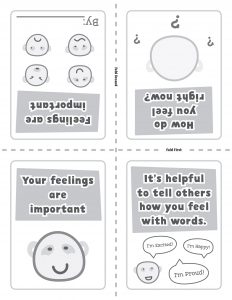 Feelings can be hard for children to talk about. Often they demonstrate their feelings before they can use words to share them. As adults, we can often be proactive when we are crabby or tired or frustrated and change our behavior. Most children are still learning to navigate that. Helping children use words to describe what is happening inside them is an important part of Social and Emotional Learning. Talk with the children you care for frequently about how they are feeling and share how you are feeling too!
Feelings can be hard for children to talk about. Often they demonstrate their feelings before they can use words to share them. As adults, we can often be proactive when we are crabby or tired or frustrated and change our behavior. Most children are still learning to navigate that. Helping children use words to describe what is happening inside them is an important part of Social and Emotional Learning. Talk with the children you care for frequently about how they are feeling and share how you are feeling too!
The Feelings Song (You Can Feel It)
Sometimes you’re happy
Sometimes you have a hard day
If you are anxious or feeling strong
You can find your feelings in our song
Find a little hope in the words we sing
Get a little help from the melody
If you’re thinking about what’s right and wrong
It helps you when you feel it with a song
And you can feel it – music can say how you feel
You can feel it – your feelings are yours and they’re real
You can feel it – and you are smart enough
To figure out what to do
And you can feel it – you can find your true voice
You can feel it – saying make the right choice
Let our feelings song
Help to see you through
© 2020 Tepsich/Welsh
Activities
Think About It
Standard: 16.1.PK-K.A – Distinguish between emotions and identify socially accepted ways to express them. 16.2.PK-K.5S Express an opinion about a story or experience using visual supports and speaking prompts (e.g., I think…; I like…).
Use your words and Say How You Feel
Watch this video together. Daniel and his friends sing about using their words so that others can know how they feel. Ask children what feeling words they might know. Discuss times when they might have felt happy or worried, excited or disappointed.
Do It
Helping children tune into feelings can help them build empathy skills and feel more in control of their own feelings. Turn it into a game to make it fun!
Feeling Charades
Standard: 16.1.PK-K.A – Distinguish between emotions and identify socially accepted ways to express them. 10.4.PK-K.A – Demonstrate coordination of body movements in active play.
Challenge your child to make facial expressions for different feelings. Pick a feeling, cover your face and then reveal your face expressing the feeling (sad, mad, surprised, deep in thought, scared, embarrassed, happy, worried, frustrated, etc.). Then take turns seeing if you can guess the emotion your child (or you) is acting out.
Parade of Feelings
Standard: 16.1.PK-K.A – Distinguish between emotions and identify socially accepted ways to express them. 10.4.PK-K.A – Demonstrate coordination of body movements in active play
Invite your child to march in a “Parade of Feelings.” Ask things like, “How would you march if you were angry?” “What if you were scared, sad or happy?” “How could we march like we are proud? Or bored?” Encourage your child to be dramatic with their bodies and facial expressions.
Mirror, Mirror
Standard: 16.1.PK-K.A – Distinguish between emotions and identify socially accepted ways to express them. 10.4.PK-K.A – Demonstrate coordination of body movements in active play
Play the mirror game to imitate someone’s movements or expressions. Stand or sit facing each other, then take turns trying to copy the other person’s expressions or movements like you’re their reflection. Take turns being the leader and the reflection.
Angry Feeling Strategies
Standard: 16.1.PK-K.A – Distinguish between emotions and identify socially accepted ways to express them. 10.4.PK-K.A – Demonstrate coordination of body movements in active play
Help children think about what they can do when they feel angry. Make a list and practice how these movement activities make our bodies feel: Go for a walk, Run fast, Pound clay, Wrinkle scrap paper, etc.
Make It
Shape Monsters
Standard: 2.3.PK.A.1/2.3.K.A.2 – Identify and describe shapes 3.2.PK.A.1 – Sort and describe objects according to size, shape, color, and texture 1.4.PK-K.B – Use a combination of drawing, dictating, and writing.
- Help children brainstorm a list of emotion words like
- Sad – disappointed, hurt, gloomy, lonely, miserable, withdrawn
- Happy – cheerful, confident, delighted, excited, glad, loved, pleased, proud, satisfied, terrific, thankful
- Mad – annoyed, crabby, enraged, frustrated, grouchy, grumpy, irritated
- Supply children with a variety of shapes cut out of construction paper (types, size, color). Discuss attributes of each shape (lines, angles, etc). Children can glue shapes to create monsters signifying different emotions. Add faces and hair using scrap materials you have on hand.
Extend It: Children can graph how many of each shape was used to create the monster. Children can dictate or write a story about the monster and the emotion. Challenge children to create 2 happy or sad monsters but discuss how the words and actions might be different if the monster is hurt as opposed to lonely or thankful rather than proud.
Feelings Faces Book
Standard: : 1.4.PK-K.B Use a combination of drawing, dictating, and writing. 10.5.PK-K.A – Use hands, fingers, and wrists to manipulate objects.
- Use old magazines and cut out the faces of people with different feelings. You can also search for images of people’s feeling faces. Try to find actual faces—not clip art.
- Fold paper to make a book and glue one face to each page. Label the feeling you think each person is expressing.
- Read your Feeling Book together.
Extend It:
Understanding Emotions with a Feelings Faces Chart
Make “Get Out the Mad” Cookies
Standard:: 2.4.PK-K.A.1 – Describe and compare measurable attributes of length and weights of everyday objects 10.5.PK-K.A – Use hands, fingers, and wrists to manipulate objects
How do you talk with your children about managing feelings? This activity encourages children to find another way to deal with feelings like anger and frustration. Tip: The cookies taste better the more you pound on the dough!
Share It
Standard: 16.1.PK-K.A – Distinguish between emotions and identify socially accepted ways to express them. 16.2.PK-K.5S Express an opinion about a story or experience using visual supports and speaking prompts (e.g., I think…; I like…). 1.5.PK-K.C Ask and answer questions…to seek help, get information, or clarify something.
Ask your child:
- What makes you feel mad?
- What might make other people feel angry?
- What can you do when you feel mad?
Young children are still developing their expressive language skills and are more likely to scream in frustration than say, “I am mad because you took my doll.” Parents can “listen” to children’s behavior and then help them put a name to their emotions. It might sound something like this:
- “Are you sad? You had to leave the park. Are you crying because you still wanted to play?”
- “Are you mad? Your brother knocked your tower down. Are you are yelling because you feel MAD?”
- “Look at your smile! Are you happy that you got to pet that soft, cute puppy?”
To help older children understand the cause and effect between external experience and internal emotions, show them how to form an “I” statement: “I feel _______ (insert feeling word) when _____ (share what caused this feeling).” These statements open up the door to honest communication and creative problem solving. Here are some examples of how “I” statements can be used to reframe emotions and clearly articulate feelings.
- I feel mad when my little sister goes into my room without asking me first.
- I feel sad when you go to work and I have a babysitter.
- I feel left out when my friends have a playdate and I can’t go.
- I feel peaceful when we color together and I wish we did it more often.
Try:
Standard: 1.4.PK-K.B Use a combination of drawing, dictating, and writing. 1.4.K.C. With prompting and support, generate ideas and details to convey information.
Create a feelings journal- Write or draw a picture of how you feel today. You could write “Today I feel____ because______.”
Read About It
Standard: 1.2.PK-K.J – Use new vocabulary and phrases acquired in conversations and being read to. 1.3.PK-K.B – Answer questions about a particular story (who, what, how, when, and where)
Where the Wild Things Are, by Maurice Sendak
This book allows children to explore the consequences of actions. Children can discuss how Max deals with his feelings and begin to recognize the ways loved ones can help children through big emotions.
The Feelings Book, by Todd Parr
This book uses simple language and vibrant illustrations to engage children in learning about different ways people can feel. The Feelings Book can be used to start discussions and help children know that it is okay to have many different feelings.
The Color Monster, by Anna Llenas
This book helps children identify feelings through the use of color. The Color Monster has many different feelings throughout the day and begins to learn how to control his feelings.








